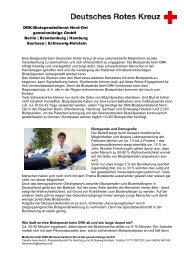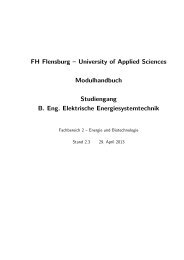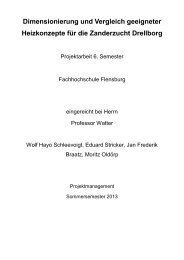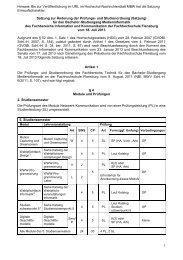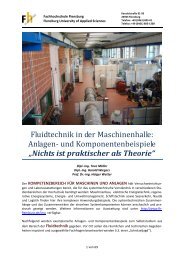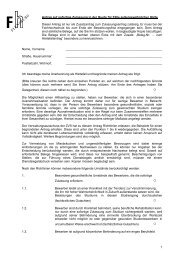- 1 - Studienordnung für den Master-Studiengang Computer Aided ...
- 1 - Studienordnung für den Master-Studiengang Computer Aided ...
- 1 - Studienordnung für den Master-Studiengang Computer Aided ...
Create successful ePaper yourself
Turn your PDF publications into a flip-book with our unique Google optimized e-Paper software.
The stu<strong>den</strong>ts will develop their expertise and hands-on experience with individual projects and<br />
exercises, using state of the art laboratories.<br />
Lectures will be complemented with hands-on training on commercial codes.<br />
Modul SS 3<br />
Computational Fluid Dynamics<br />
Computational Fluid Dynamics (CFD) is one of the modern software tools which today contributes to<br />
the methods found in <strong>Computer</strong> <strong>Aided</strong> Engineering (CAE). It can either be used to design the detailed<br />
structure of fluid machinery, for example, or to model processes within flowing matter. As in many<br />
other field simulations using CFD, the region of flow concerned is subdivided into an arbitrary number<br />
of cells for which the conservation equations of mass, momentum and energy are solved.<br />
CFD simulations are carried out according to the following steps:<br />
• The working volume where the flow is to be modelled is usually designed with the aid of CADsoftware<br />
according to fluid dynamic behaviour. This means the choice of proper boundary<br />
conditions and resolution of geometric details. This pre-processing finishes with the subdivision of<br />
the volume into cells with some experience of the expected flow pattern.<br />
• In the next step the user sets up a model of the fluid flow. This is to decide whether the flow is<br />
laminar or turbulent, compressible or incompressible, Newtonian or non-Newtonian, and to<br />
construct the conservation equations accordingly. Before the user submits his/her model to the<br />
solver it may be wise to select special discretization schemes for some differential terms of the<br />
conservation equations. This will help to enhance stability during solution.<br />
• Solution is the step with the lowest work load for the user, but with the heaviest load for the<br />
computer. Due to the character of the conservation equations, an iterative solution procedure is<br />
necessary for the simultaneous calculation of often more than 100,000 variables.<br />
• Once a stable and converged solution is obtained the post-processing consists mainly of graphical<br />
visualisation of flow. Other figures of interest are overall balances and forces exerted on certain<br />
surfaces.<br />
Applying CFD today one usually employs commercial software, which offers a high degree of<br />
automation and comfort. This means most of the steps described above can be accomplished by a<br />
qualified user who puts everything together from the ‘model menus’ of the software.<br />
The CFD course comprises the following:<br />
1. Introduction to Computational Fluid Dynamics<br />
2. Conservation of Mass, Momentum and Energy<br />
3. Turbulence - Phenomenon and Modelling<br />
4. Grid Design<br />
5. Numerical Methods to Solve the Conservation Equations<br />
6. Discretization Schemes<br />
7. Solving Strategies<br />
8. Flow Modelling of heat and mass transfer<br />
Lectures will be complemented by exercises with a commercial CFD code.<br />
Modul SS 4<br />
Data Management<br />
Data management and data bases are used in modern engineering to store the data of the<br />
construction process. An engineer has to be able to use and to some extent to develop such data<br />
base applications.<br />
- 7 -






